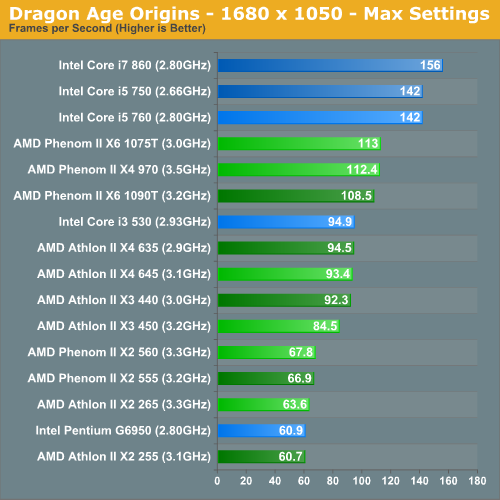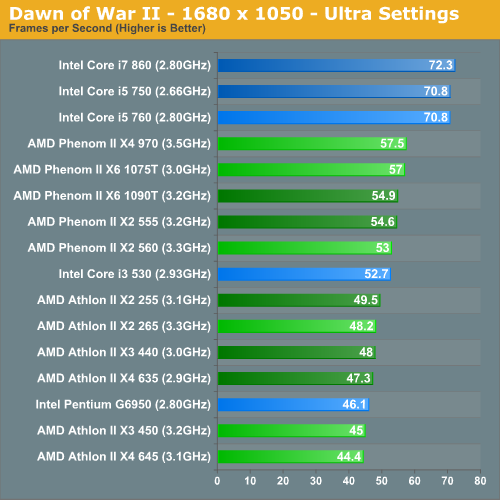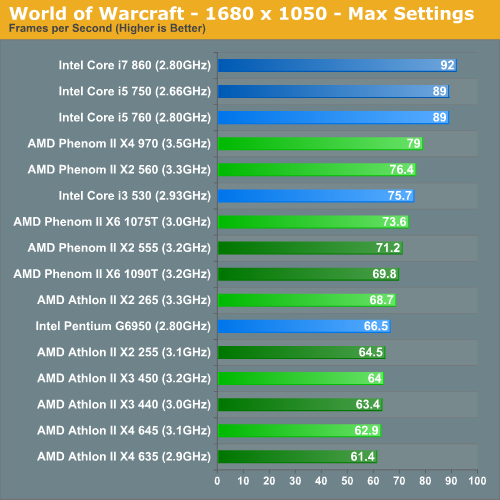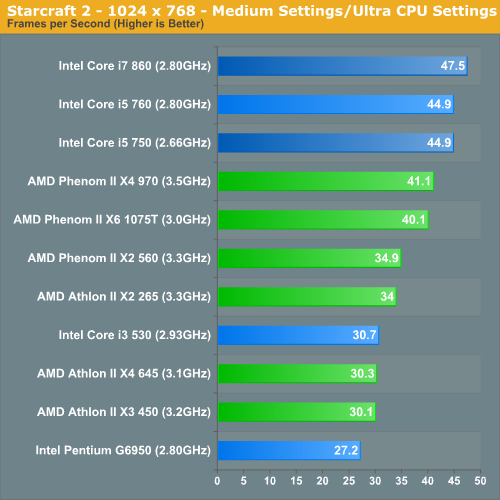AMD's Fall Refresh: New Phenom II and Athlon II CPUs Balance Price and Performance
by Anand Lal Shimpi on September 21, 2010 2:52 AM EST- Posted in
- CPUs
- AMD
- Phenom II X6
- Athlon II
Sonar 8 Audio Mixing Performance
In our only digital audio production test we take a multi-track recording and export it to a WAV file using Sonar 8. The benchmark isn't very well threaded and prefers two very fast cores to several slower ones:

As I mentioned before, this is the biggest issue with AMD's lineup. If you're running applications that can't use the extra cores, AMD's advantage typically disappears.
Gaming Performance

At the high end, AMD's Phenom II X6 and X4 lose to the similarly priced Lynnfields. In the middle the Athlon II X4 645 and Athlon II X3 450 do very well.

With the exception of the Phenom II X6 and X4 processors, AMD is generally competitive here. Intel maintains the performance advantage above $200. There's an unusual amount of variance in our tests here (particularly old vs. new AMD results). The variance appears to be caused by the platform shift as we moved all of our AMD testing to the same 890GX motherboard. The change in performance under Dawn of War II however doesn't really change the standings.

WoW performance is governed by two threads thus negating any core count advantage. AMD loses at the high end but is competitive around the $100 mark.

Starcraft 2 performance is something we're beginning to look at. Again we have a situation where a game doesn't use more than two cores. The Phenom IIs are slower than Lynnfield, while the multi-core Athlon IIs do well against their competitors. If you're building a fast Starcraft 2 box that doesn't have to do anything else, the dual-core CPUs do better here.










98 Comments
View All Comments
hangfirew8 - Wednesday, September 22, 2010 - link
I love competition. I want choices, not just at the lower end price points.The real issue is that AMD has not improved their instructions per clock cycle ratio substantially since the earliest K8's. AMD caches have gotten larger, HT has gotten faster, power saving features have gotten more sophisticated, clock rates have gone up, but we've yet to see any real jump in core processing efficiency.
Until AMD addresses that they will stay on the low end, with the low end margins that come with that market.
bji - Tuesday, September 21, 2010 - link
Fry's had a sale on these last week; you can see the advertisement for this sale at:http://newspaperads.mercurynews.com/FSI/Page.aspx?...
$179.99 for the Phenom II 1075T seemed like a good deal to me so I picked one up. I still don't even have any of the other system components I need to run this thing; but the deal was so good that I just had to jump. I'll buy motherboard, memory, etc later ...
The weird thing is the AMD seal on the top of the box lists it as a 1075T and says its clock rate is 2.8 Ghz. Didn't notice this until I got home. I wrote to AMD to ask about it and they replied that they had some printing problems with the labels and some boxes went to vendors with that printing error. But they assured me that it's really a 3.0 Ghz part.
Gilbert Osmond - Tuesday, September 21, 2010 - link
I notice on the photos of the chip packages it says:DIFFUSED IN GERMANY
MADE IN MALAYSIA
I've not seen the "Diffused in..." marker ever before on a chip package. What does it refer to / mean?
Gilbert Osmond - Tuesday, September 21, 2010 - link
I've found a complete (exhaustive) answer to my own question, here:http://www.faqs.org/rulings/rulings2007HQW968421.h...
The long and short is that the separate markings help to resolve an ambiguity about the country-of-origin.
LoneWolf15 - Tuesday, September 21, 2010 - link
While I like Intel CPUs, it seems that good 1156/1366 mainboards are so expensive compared to Socket AM3.It'll be awhile before I replace my Q9650, but when it happens, if Intel hasn't worked with vendors to make mainboards more reasonably-priced, I see AMD as a real possibility.
Taft12 - Tuesday, September 21, 2010 - link
It's not board OEMs that are causing motherboards to be unreasonably-priced, it is Intel with their chipset pricing. Despite moving the IGP off of the chipset (a huge cost elimination), the wholesale price stayed the same.3rd party chipset competition is needed desperately but Intel will have none of that! AMD boards definitely give you more for less.
mino - Tuesday, September 21, 2010 - link
Actually this sad fact is affecting the AMD market too.It seems Nvidia has completely occupied the low-end market while AMD IGP boards have moved up on the price scale around $10.
Also check CPU prices - there is no AMD dual core below $60 with artificially sold single cores for $40.
Basically while the performance you can buy at $60 has gone up 2x over last 3 yrs on ADM side, their $40 offing is now useless while previously it was relatively reasonable.
AMD sees no competition from Intel there => no low end dual cores.
iamkyle - Wednesday, September 22, 2010 - link
For the majority of the market out there, you may be getting to a level where the performance of the CPU is good for what, embedded applications? Linux servers that can be run on used hardware for $20? Niche applications.At least there is speed at the low price points to fulfill a multitude of uses.
Taft12 - Friday, September 24, 2010 - link
I would think AMD's can't sell any CPU for less than about $65 without going deep into the red on every unit. Think about raw material costs, electricity, clean room maintenance, shipping, packaging, ... This is before accounting for any R&D or payroll for a single employee!Similarly, I think we're at an absolute floor at about $40 right now for hard drives.
SonicIce - Tuesday, September 21, 2010 - link
good article and good cpu's. you should highlight which chips are the new ones in the beginning chart